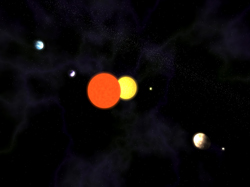Star-on-star interactions
Studying binary stars, a system of two stars orbiting around their common mass centre, permits a precise determination of stellar masses and can reveal unique evolutionary paths. However, there are major theoretical gaps in models of the physical processes occurring during the evolution of interacting low- and intermediate-mass binaries. One ways to overcome this is to look at the result of their evolution. The 'Detailed modelling of low- and intermediate-mass binary stars' (LIMBS) project focused on such stars to better understand the physical processes at play in their interaction. The EU-funded project aimed to build on existing expertise in single star evolution so as to produce a computational framework for calculating binary star evolution. Using the work of an existing stellar evolution code, the LIMBS project was able to construct a new binary stellar (BINSTAR) code. BINSTAR was extended to follow the evolution of both stars in a binary system. Researchers first modernised the existing code to make it more modular, and then redesigned its structure so it could 'run' two stars at the same time. Next, they worked to introduce binary star physics to BINSTAR, something made more feasible given the code's new modular nature. Although various difficulties presented, the testing of the new BINSTAR code eventually returned favourable results. LIMBS project partners encountered varied obstacles in the final planned stage of development of BINSTAR. However, a modified approach resulted in a new formalism that is considered a significant step forward in efforts to model interacting binary-star systems. The LIMBS project succeeded in delivering its main goal of developing a new, self-consistent, detailed binary stellar evolution code. The results of this project have set the groundwork for a programme on detailed modelling of binary stars at the Institute of Astronomy and Astrophysics (IAA) at l'Université Libre de Bruxelles (ULB) in Belgium.




